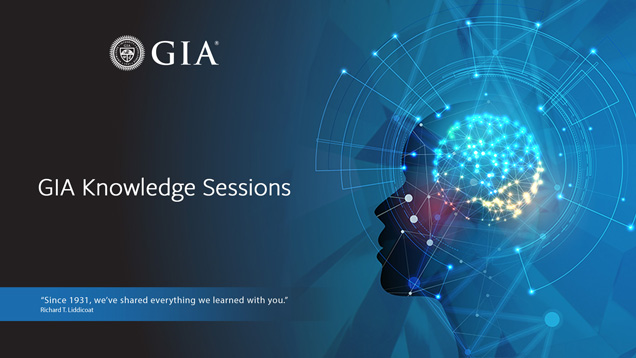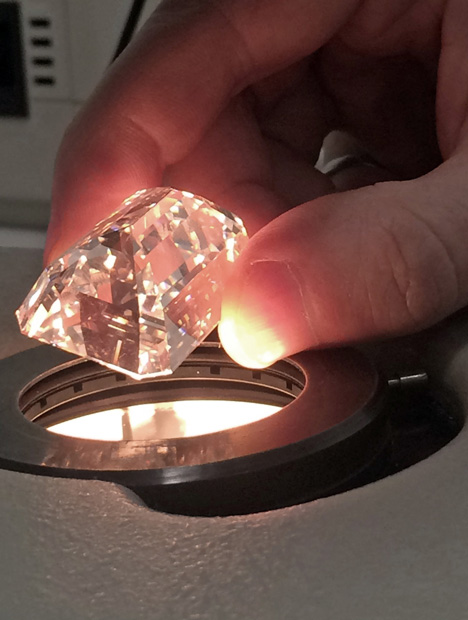GIA’s Knowledge Sessions: A New Way to Share Gemological Information
August 17, 2020
Video calls and webinars have taken the world by storm ever since the coronavirus sent everyone home for safety. They are an easy way to stay connected with family and friends and many — including GIA — are using them to share knowledge.
GIA’s Knowledge Sessions began in early April and since then, they have covered a variety of gemological research topics, including pearls, laboratory-grown diamonds, field gemology and jade auctions. The hour-long sessions provide an opportunity for researchers and subject matter experts to stay connected with the other researchers, retailers, designers and other people who are excited to learn more about the world of gems and the jewelry industry, in a friendly, more casual format.
“Our researchers normally speak at seminars and conferences, but now that we can’t travel as a result of the pandemic, we saw there was another way to connect with the research community to share our information,” says Kellie Giordano, GIA senior manager of content marketing and the moderator of the web sessions. “Our researchers are so talented and great at communicating all of this complex research in an accessible way. The webinars evolved into a resource for the entire gem and jewelry industry to understand how they might apply the research GIA is doing every single day into their work — as a retailer, wholesaler or whatever stage of the supply chain they are in.”
Dr. Mike Breeding, who presented “Laboratory-Grown Diamonds: Updates and Identification,” says the webinars speak to GIA’s mission to protect the public and giving them the information they need to thrive in their area of interest.
“Many trade members can’t afford the time or money to attend conferences or pay for on-campus seminars, so this is a fantastic mechanism for us to get important information to them to help in their daily challenges in the gem industry,” he says. “People are already excited about gems, but these types of informative webinars really give them even more to be excited about and empowers them with knowledge.”
The number of people who sign up and attend each session is surprising, but gratifying, to the presenters. To-date, there have been more than 48,000 registrants and more than 21,000 attendees in 21 presentations and more than 65,000 views (with a total of more than 10,000 hours watched) on YouTube, where all of the sessions are posted.
“The webinars are a fantastic way to reach all corners of the globe, even if someone has to get up super-early, or stay up super-late to see it,” said Robert Weldon, director of the Richard T. Liddicoat Library and Information Center, who presented “Behind the Scenes: Untold Stories from GIA Field Gemology Expeditions,” with Wim Vertriest, supervisor of field gemology and Dr. Aaron Palke, senior manager of research. “As evidenced on several of the talks, thousands of people have tuned in at one time.”
The webinars are held weekly in English, but several have been presented in Mandarin, such as “An Exclusive View of the World’s Biggest Jade Auction,” by Dr. Tao Hsu, director of global development, “The Fascinating World of Pearls and Shells,” by Dr. Chunhui Zhou, manager of pearl identification, “Laboratory-Grown Diamonds from China,” by Dr. Wuyi Wang, vice president of research and development, and “Advanced Analytical Techniques,” by Ziyin Sun, research associate.
Wang said the webinars are an effective way to share gemological research findings with a large number of people at a time. “It is impossible to attract this many people to attend any on-site presentation,” he says. “We should sustain this platform.”

A New Format for a New Gem and Jewelry World
GIA Knowledge Sessions cover a broad spectrum of topics, from some of the more popular gemstones — diamonds, pearls and rubies — to lesser-known aspects of gem exploration and research tools.
“We’re really looking to provide a wide range of topics. We have this wealth of knowledge and we want to use these webinars to deliver as much of it as we can,” Giordano says.
Presenting the information in a webinar format, as opposed to a conference setting, was a little strange for the researchers at first, but they quickly adjusted.
“I was pleasantly surprised at how easy it was to present the webinar,” Breeding says. “At first it was a bit weird to not see the people as I talked, but as it went on, it was very relaxed and easy to discuss the slides and information.”
Dr. Zhou says that as he sat alone in a room talking in front of the screen, he wondered what the audiences were doing at the moment in different parts of the world, but that it was less stressful than presenting in person at a conference.
“It is a great way to share information and connect with the trade and public during this extraordinary period of time,” he says. “The technology advances make it easy for anybody to join from all over the world and they can even watch a recording after the talk.”
The benefits of an online presentation — no need to travel, watching from anywhere in the world and on-demand viewing — also include an easy-to-follow format for the presenter and the viewer.
“I enjoy the 45-50 minute talking time slot we get. This allows you to really tell a story, but at the same time forces you to bring structure to it. It’s always easier to see or listen to someone explain it thoroughly,” says Vertriest, who also presented “Rubies: Connecting Sources, Treatment and Science” and “Geology 101 for Gemologists: The Natural Processes that Form Colored Gemstones.”
“A good presentation takes you by the hand and leads you through all the challenging science that might appear overwhelming in written format,” he says. “Since presentations are very visual, the information can also be presented in a more intuitive way.”
It also enables the audience to ask questions through a chat feature during the presentation and at the end of it.
“I could see the questions pop up on the side as I went and it was difficult to not try to answer them immediately,” Breeding says. “I found myself remembering to include small details that I might have otherwise skipped because I knew someone was wondering about it.”
The questions also indicated that there were both insiders in the gem trade and general public listening to our talks, Chunhui says.
“It was also surprising to see the range of questions. Everyone has a different perspective and it is interesting to see what details people pick up on,” Smith says.
Nick Sturman, senior manager of identification, who presented the “Fascinating World of Pearls and Shells,” suggested that extra dialogue specific points can be raised on GIA's Gems & Gemology Facebook page. “So far that hasn't happened much but a few people have taken the opportunity to raise a point,” he says.
“I have been so pleasantly surprised by the participation,” Giordano says. “We get so many great, high-quality questions and there is so much curiosity around each topic.”
She said that post-webinar surveys indicate that 95% of participants agree or strongly agree that the topic was valuable, 95% rate the session as excellent or good, and 100% want to attend another GIA Knowledge Session.
Some of the anonymous comments from the survey:
-
“I really appreciate GIA producing these webinars during the pandemic times, they’re interesting and keep us connected.
- “It is truly amazing how the webinars help to connect the theoretical knowledge [that] is acquired during the self-study to a more practical approach. Already looking for the next one!”
- “What really impressed me, along with the expertise, was the friendly, informal presentation. Fun!”
GIA’s Digital Transformation is Underway
“Knowledge Sessions are a great example of how we are using modern technology to connect with our GIA community,” says Mark Buntz, senior vice president and chief marketing officer. “We want to make it easy for researchers, students and alumni to access our expertise and spark an even greater interest in gems and jewelry around the world.”
Dr. Hsu agrees that webinars and other digital tools are an effective way to share many different type of information - not just that limited to gemological research. “Educational information and even retailer support type of information can all be shared this way,” she says.
She presented “GIA Research - Not Just for Scientists,” a behind-the-scenes look on how GIA designs its world-respected curriculum.
GIA is also making other outreach efforts online, including a GemFest on the “Geographic Origin Determination of Ruby,” which was presented in Japanese from Tokyo and the 115th Gemstone Gathering, a popular event in Thailand, on “Precision Cut: How, Why and When?” by Victor Tuzlukov, a well-known master lapidary artist.
Above all, says Dr. Evan Smith, who presented the first GIA Knowledge Session – “The Unique Story of Natural Diamond” — in early April, the webinars help showcase some of the things that distinguish GIA from other gem labs.

“Some people may know GIA best as an issuer of certificates and accreditations, but its mission is much broader,” he says. “The Knowledge Sessions shed light on the diverse nature of work that goes on behind the scenes at GIA, and our commitment to re-investing into research and education.”
Go to GIA Knowledge Sessions to register for an upcoming webinar or watch one that has already been presented.
Amanda J. Luke, a senior communications manager, has been an editor and writer at GIA for 19 years.



